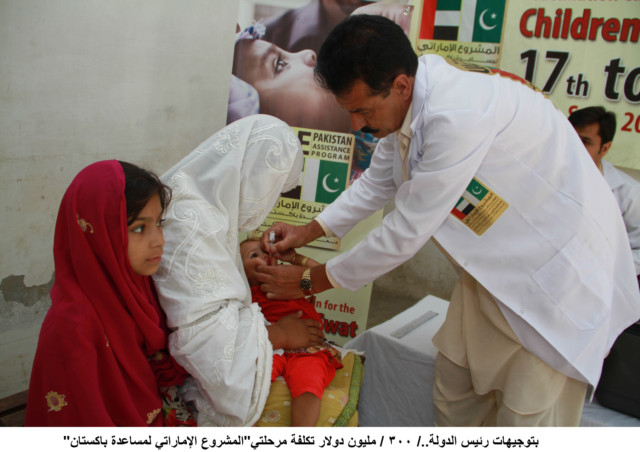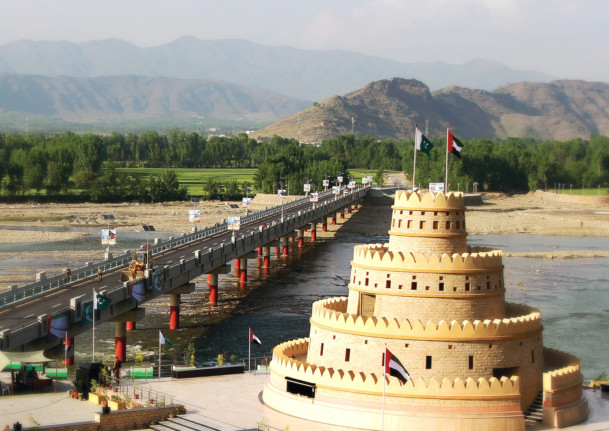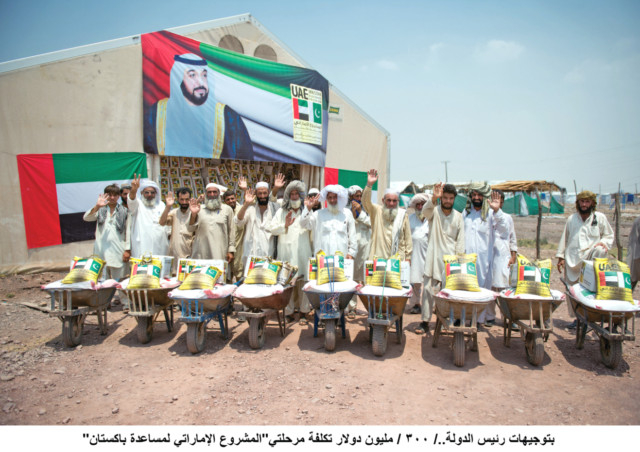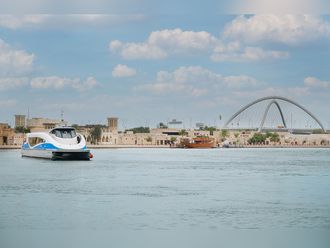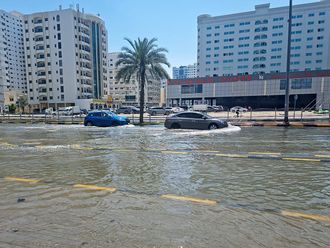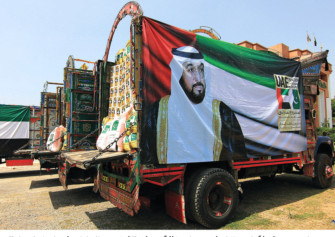
Islamabad: The total cost of projects carried out in the first and second phase of the UAE Project to Aid Pakistan (UAE PAP) amounted to $300 million (Dh1,102 million).
The UAE PAP was launched on January 12, 2011, upon the directions of President His Highness Shaikh Khalifa Bin Zayed Al Nahyan, with the intent to help Pakistan overcome the consequences of the destructive torrential rains by rehabilitating infrastructure. The project follows a comprehensive plan of rehabilitation that takes into account the rugged geographical topography and harsh weather conditions. The plan has four main pivots to rehabilitate the area and secure community development: roads and bridges, education, health and water supply. It also provides for additional efforts to offer humanitarian assistance to the unprivileged, poor and homeless.
In roads and bridges, two flood-wrecked bridges were rebuilt over Swat River, in addition to a number of modern asphalt roads in southern and northern Waziristan. In education, UAE PAP built, reconstructed and rehabilitated 60 projects including schools, institutes and academic technical colleges for male and female students in remote areas.
In health, 8 projects were carried out to build hospitals, health clinics and medical institutes. In water supply, 76 water treatment and purification plants were set up and to extend potable water pipes extended and humanitarian assistance, including foodstuff, dates, school back bags, was extended. Sera were provided and anti-measles and infantile paralysis campaigns were organised.
The generous initiatives of Shaikh Khalifa, General Shaikh Mohammad Bin Zayed Al Nahyan, Abu Dhabi Crown Prince and Deputy Supreme Commander of the UAE Armed Forces, and the continuous follow-up of Shaikh Mansour Bin Zayed Al Nahyan, Deputy Prime Minister and Minister of Presidential Affairs, were the main factor behind the success of UAE PAP and also behind achieving the humanitarian goals, which aim to develop the infrastructure projects.
The UAE PAP was launched with the aim of providing help and humanitarian assistance to the people of Pakistan and support their development initiatives for a better future.
Its mission is to execute development assistance projects that offer sustainability and continuous benefits to beneficiaries in the long run.
Development assistance projects of this kind are comprehensive by nature in order to help all sects, age groups and social classes of the Pakistani community, especially the orphans, handicapped, children, women, elders and the Pakistani people in general.
UAE PAP is a non-profit voluntary contribution project, which offers multiple social, health, educational and economic assistance to the needy, in various areas, cities and villages across Pakistan.
Its mission objectives include, but are not limited to, providing assistance to the people of Pakistan by developing poverty elimination programmes, upgrading the educational system/environment, upgrading medical services and e community health environment and helping to create job opportunities for Pakistani nationals in order to eliminate unemployment and improve the economic conditions.
UAE PAP has a broad scope for projects throughout its mandated region of operation, which include the building of modern roads and bridges to help establish inter-province/intercity access points and secure means of easier travel for the people.
— To build, maintain and restore schools, colleges and academic institutions while helping to upgrade the educational infrastructure and prepare students to earn academic credentials and obtain training experience.
— To build, renovate, maintain and refurbish hospitals, clinics and medical institutes to extend badly needed modern medical care to Pakistani families in order to alleviate their suffering and protect them against diseases and epidemics.
— To build water treatment and purification plants, extend delivery networks to provide remote towns and villages with potable water and eliminate the problem of unsafe water.
— To deploy humanitarian assistance to the poor, orphans, needy and homeless, provide food and health care to help them overcome their ordeal.
UAE PAP adopted an all-out development plan to carry out vital projects to serve the Pakistani nation. The total cost of the projects in both phases, i.e. the first and second phases, have so far reached $300,368,000.
Breakdown of projects
Roads and Bridges
Swat Valley and north-western areas of Pakistan were obliterated by the destructive seasonal floods, which fully devastated the infrastructure, leaving the debris of destroyed bridges. It was impossible to travel across the Swat River and the region was entirely cut off, making it impossible to deliver food, tents and medical supplies to the homeless in a timely manner. Inhabitants found it extremely hard to travel and had to suffer a real ordeal by having to use remote unmaintained roads and unconventional means of transport.
With no macadamised roads available, the inhabitants of South Waziristan suffered a similar ordeal, which had a heavy toll on them socially, economically and educationally. For this reason, the region lost any hope for development.
UAE PAP carried out four road and bridge projects at a cost of $121,580,000, which included the reconstruction of two flood-destroyed bridges on the Swat River and building two new roads in South and North Waziristan.
These are among the most vital projects with a huge contribution to the development of infrastructure in remote areas in Pakistan. They also help in the social, economic, educational and health development of the targeted areas.
Of particular significance is the reconstruction of the Shaikh Khalifa Bin Zayed Al Nahyan Bridge, which was originally constructed 40 years ago but destroyed by floods, leaving many villagers cut off and without necessary relief or supplies. The bridge is the most important in Khyber Pakhtunkhwa Province, a main artery for provincial inhabitants and a vital link to the provincial highway. The 330 metre-long, 10 metre-wide, 6 metre-high bridge has a capacity of more than 5000 vehicles daily and serves as many as 70,000 commuters.
As for the technical specifications, all metal works were fabricated in the United Kingdom, and special technical and engineering specifications were applied in the manufacturing and erection processes as per international standards, including seismic and flood resistance, by supporting river banks with a 900 metre-long water barrier.
Anti-erosion, rust and humidity reinforced concrete bases support the bridge, which was supplied with a solar powered lighting system. Management and operation facilities were built and a pedestrian lane, parallel to the vehicles’, was added. The project cost $12,460,000.
Shaikh Khalifa Bin Zayed Al Nahyan Bridge is a new architectural landmark in the heart of Khyber Pakhtunkhwa Province, and its strategic location on the Swat River makes it an indispensable part of the Province’s main road network and a tourist attraction, thanks to its unique aesthetic design, which is similar to the one used for the Al Maqtaa Bridge in Abu Dhabi.
It boasts a beautiful heritage-oriented look with historical crenellated fortress structures at both ends which incorporates age-old traditions of the UAE infused in a modern state-of-the-art design and manufacturing process.
This vital bridge was named after the late Shaikh Zayed Bin Sultan Al Nahyan as a sign of gratitude, recognition and appreciation of his significant generous development efforts to assist the people of Pakistan over the years. Shaikh Zayed was a solid supporter of Pakistan and was keen to help Pakistanis achieve progress and development in various humanitarian, developmental and cultural aspects.
The Shaikh Zayed Bin Sultan Al Nahyan Bridge was also destroyed by the floods, leaving many villagers cut off and without necessary relief or supplies. The bridge is also important in Khyber Pakhtunkhwa Province, as it provides a main artery for provincial inhabitants and a vital link to the provincial highway. The 448 metre-long, 10.7 metre-wide, 7 metre-high bridge has a capacity of more than 4000 vehicles per day and serves as many as 2,000,000 commuters in an area of 1,235 square kilometres.
Again, special technical and engineering specifications were applied in the manufacturing and erection processes as per international standards, including seismic and flood resistance by supporting the river banks with a 1,300 metre-long water barrier. Anti-erosion, rust and humidity reinforced concrete bases support the bridge, which was also supplied with a solar powered lighting system.
Management and operation facilities were built and a pedestrian walkway was added. The project cost $10,510,000.
Shaikh Khalifa Bin Zayed Al Nahyan Road also serves as a third strategic crossing between Pakistan and Afghanistan, cutting the distance between Karachi and Kabul by about 400 kilometres.
The 50 kilometre-long road boasts ultra-modern engineering and technical specifications. It has 5 bridges, 105 sewers, side protection walls, 16.8 kilometre-long cement beams, and is 4,800-8,600 feet above sea level. Topography-wise, 50 percentage of the road passes through valleys and 50 percentage through mountainous terrain. The gross cost of the road amounted to $38.01 million.
Today, the inhabitants of South Waziristan find life more convenient and are able to travel easily and enjoy the exquisite scenery along Shaikh Khalifa Bin Zayed Al Nahyan Road, which provides them with a new artery for life and modern culture.
Makeen-Miranshah Road is a modern development project being carried out in both South and North Waziristan. It is a vital transportation project that links Makeen in the north of South Waziristan with Miranshah in the northern FATA Province, and serves the inhabitants of 3 towns and 20 villages. The 72 kilometre-long, 9 metre-wide Makeen-Miranshah Road cuts through one of the most difficult and rigid mountainous areas, and crosses over 10 bridges, each being 10.4 meters wide. The bridge, which has 172 sewers, side protection walls, and 26.2 kilometre-long cement beams, cost $60,600 million.
Education
Educational premises were severely hit and devastated by seasonal floods and military operations, leaving local students short of schools and forced to study in the open air, in tents, on rooftops or in makeshift venues. The situation worsened in winters due to the harsh weather conditions.
It became even worse for girls who could not commute to distant schools. Ambitions and dreams of a better life were washed away by floods, thus making students of stricken areas suffer the loss of a full academic year due to lack of schools, universities and institutes.
UAE PAP Education Score Sheet
Number of Projects: 60, Cost: $41,519,000
UAE PAP took the initiative to help Pakistan by building and equipping 60 educational projects as per modern international standards. This initiative was taken upon the directives of Shaikh Khalifa, to support and upgrade the educational infrastructure in Pakistan and build proper facilities for students to study in a convenient environment.
Educational projects were carried out in a number of regions in Khyber Pakhtunkhwa, South Waziristan, Bajaur and Mohmand Agency, where students had lost their schools and had to make an exhaustive trip on a daily basis in order to reach schools in remote locations.
Under the plan carried out by the UAE to upgrade primary, higher and academic education in Pakistan, newly built schools, colleges and institutes were equipped with the latest educational aids and academic and computer labs to enable students to learn modern science on the latest equipment from primary up to higher-studies stages. Workshops equipped with practical and technical training equipment and all the requirements for diploma-level students were also provided.
Schools built in those regions represent a huge contribution by the UAE. The generous humanitarian initiatives of His Highness Shaikh Khalifa played an active role in the academic and cultural rehabilitation and upgrading of the individual — a role these educational institutions will pursue and extend to a new generation of the Pakistani people — one adequately capable of meeting future challenges.
Swat-based Women Vocational Training and Rehabilitation Centre (WVTRC)
The Women Vocational Training and Rehabilitation Centre (WVTRC), the first of its kind, was set up in Khyber Pakhtunkhwa at a total cost of $481,649. The 25,000 square feet centre was equipped with the latest specialist machines and equipment to train women in sewing, embroidery, leather ware, design and decoration. The centre also offers training courses in designing artefacts, sewing and tailoring, beauty and wax making, cooking and first aid.
The centre serves to empower Swati women and help them run their houses financially by acquiring modern training-based skills.
Upon female trainees’ request, and to ensure their safe travel from and to the centre in difficult conditions, a new bus was gifted by UAE PAP management to alleviate their suffering.
The directives of Shaikh Khalifa resulted in the sponsorship of 53 projects as a first stage to absorb 30,000 students. As many as 43 primary to secondary schools and 10 technical colleges and institutes were built under this project.
Bajaur College of Technology (BCT) was designed to contribute to the all-round development of the individual and the community in Pakistan. It is a valuable essential asset to improve the living conditions of the youth and open the labour market for them. BCT’s mission is to train and raise the skills of high school graduates and prepare them to be effective elements in the community, capable of raising their own technical and practical skills and becoming self-dependent. BCT is also destined to play a leading role in boosting industrial and agricultural development to the highest level possible.
Key to this development is to prepare and upgrade well-trained manpower, which is capable of handling modern technology in various specialities — a mission accomplished by BCT, which boasts the latest educational aids, programmes and vocational training.
BCT, which cost $3.418 million, spans 45,000 square feet and accommodates a number of halls, workshops and laboratories equipped with the latest education and training machines and equipment, in addition to specialist departments for mining, mechanics, industry, electricity and technical skills. BCT is qualified to train and graduate as many as 500 students every year.
Jahanzeb Post Graduate Degree College (JPC), Swat
Jahanzeb Post Graduate Degree College (JPC), the oldest educational institution in Malakand, was established in 1952 to grant degrees in 7 specialist branches, and it accommodates 300 students. JPC was rebuilt on an area of 3,577 square metres to house modern academic departments. The new facility has a main lecture auditorium, 10 classrooms, 4 laboratories, 16 teaching and administrative staff offices and an administration building. The project was completed at a cost of $1.209 million.
Warsak College, Peshawar
Warsak College is a new institution built near Peshawar to offer specialised education to top high school achievers to prepare them to enter the fields of medicine, engineering and computing. The 600 student-College celebrates the graduation of 120 students yearly, and offers a 5 year-course of study leading to High School Certificate duly certified by the Peshawar Preparatory and Secondary Education Board qualifying graduates to enrol in university Bachelor’s degree courses.
The facility consists of an academic department, gymnasium, a mosque, a main lecture room, 12 classrooms, 3 laboratories, 8 teaching and administrative staff offices, teacher-student dormitory and a dining room. The project cost $2.017 million and Stage II of development was started at a total cost of $3.025 million.
Want College, South Waziristan
Want College is a new facility, the first of its kind in South Waziristan, which offers a specialist education to top secondary school students to qualify them to join colleges of medicine, engineering and computer science. The 3,623 square metre college, which accommodates 500 students, offers a 5 year-course of study. The facility has an academic section, a gym, a mosque, a main lecture hall, 6 classrooms, 4 laboratories, 12 teaching and administrative staff offices, teacher-student dormitories and a dining room. The project cost $2.383 million. Work is underway for Stage II at a total cost of $3.025m.
Spinkai Raghzai College
Spinkai Raghzai College is situated in Gand Wala, Southern Waziristan, where English and Urdu are the chosen languages of teaching. The College curricula were prepared by the Preparatory and Secondary Education Board in Deirat Ismail Khan. The College has 3 majors for medical, engineering and computer science pre-qualification for prep grade students who must have finished grade 7 and be 12-13 years old in order to be eligible for admission.
The College accommodates 400 students, of whom 80 graduate yearly. It offers a 5 year course of study leading to High School Certificate duly certified by the Peshawar Preparatory and Secondary Education Board qualifying graduates to enrol in university Bachelor’s Degree courses. The College, which serves the locals in Southern Waziristan, Tank, Gandola, Deirat Ismail and Banwa, has an administrative department, two academic departments, 4 dormitories for students, a dining room, lecture rooms, a hospital, a mosque, administrator-teacher dormitories, sports grounds and an equestrian club.
Wadudia Model School (WMS)
Wadudia Model School (WMS) was built as a first-of-its-kind facility in Khyber Pakhtunkhwa Province to accommodate 685 students. The 1,545 square metre, 2 story-school has a main lecture room, 16 classrooms, a computer lab, 3 science laboratories, teacher-administrator offices and modern sports grounds. The school has been equipped with modern educational aids, computers and science lab equipment. WMS cost $500,000.
Want Model School
Want Model School was built as a first-of-its-kind facility in South Waziristan to accommodate 150 students. The 774 square metre, 2 story-school has a main lecture room, 5 classrooms, a computer lab, library, teacher-administrator offices and modern sports grounds. The school was equipped with modern educational aids, computers and science lab equipment. The school cost $500,000.
Health
Even before the devastating floods struck Pakistan in 2010, not all inhabitants had access to proper health services. Women and children were the most deprived of comprehensive medical care, bringing about a high mortality rate due to lack of medical supervision in maternity cases, lack of sera, medicine and malnutrition.
Floods were the final stroke to the remaining medical services, and delay in delivering first aid supplies caused many avoidable deaths. Pain and sorrow were rampant due to a severe lack of medical supplies and rescue teams. Patients had to walk several miles to reach medical clinics, with many – especially women, children and the elderly — unable to travel or afford medical treatment because of the deteriorating economic conditions.
UAE PAP Health Score Sheet
Number of Projects: 8
Cost: $125,887,000
UAE PAP sponsored health projects were top priority in the UAE PAP humanitarian plans as the UAE political leadership, represented by the President His Highness Shaikh Khalifa Bin Zayed Al Nahyan, firmly believed that there was dire need to support Pakistan’s health sector in order to exercise its role in extending medical service and improve public health, especially in distant areas where the lack of basic and vital services was severe. UAE PAP management sponsored a number of health programmes and projects to boost Pakistan’s Health Ministry efforts and capabilities to upgrade medical services. The sponsorship provided for the setting up of, equipping and maintaining eight hospitals/clinics in Islamabad, Khyber Pakhtunkhwa, South Waziristan and Bajaur at a total cost of $125,887,000.
These projects were carried out to modern international standards, architecturally and technically, to provide high class medical care, and enable hospitals to competently extend medical treatment to those in need. Clinics were fully supplied with equipment necessary to run medical examinations, offer modern diagnosis and extend a high quality, integrated service to the locals.
Special attention was given to extending health care to women and children as a cornerstone of family health. Two model hospitals were approved to offer treatment to women, children and emergency cases: Shaikh Khalifa Bin Zayed Al Nahyan Hospital in Saidu Sharif, Khyber Pakhtunkhwa, and Shaikha Fatima bin Mubarak Hospital which is being built in South Waziristan.
Emirates Hospital
Built at a cost of $108 million, the Emirates Hospital, one of the largest health projects built in Pakistan in recent years, is a specialist hospital in the capital, Islamabad, and is designed to receive critical cases referred by other hospitals. Equipped with the latest medical laboratories and equipment to provide the best medical care, the Emirates Hospital will be academically approved to train interns. It accommodates 1000 beds to receive 6,000 patients daily (2 million each year) and 16 well-equipped operation theatres capable of executing 50 surgical procedures daily.
The 5,430 square metre, 100-bed Shaikh Khalifa Bin Zayed Al Nahyan Hospital was set up in Saidu Sharif, Khyber Pakhtunkhwa. It consists of departments as varied as general medicine, gynaecology, maternity, paediatrics and emergency, in addition to operation theatres, admission wards and intensive care units (ICU’s).
Shaikha Fatima Bint Mubarak Hospital
The 4,330 square metre, 50-bed Shaikha Fatima Bint Mubarak Hospital, which is being built in Sholam, South Waziristan, consists of an outpatient clinic, gynaecology, maternity, paediatrics and emergency departments. The Hospital boasts a kidney dialysis centre and a preventive medicine unit (both of these being the first of their kind in the region), infantile inoculation, operation theatres, admission wardens and intensive care units (ICU’s).
Bajaur Hospital
The 1,762 square metre, 70-bed Bajaur Hospital accommodates a number of specialised departments to conduct medical examinations for men, women and children. The 2-story Hospital has two patient units for quarantine, two for surgery, one for kidney dialysis, a brain image analysis unit (BIAU) and 14 patient care and nursing rooms. It has psychology, chest disease and urology departments, outpatient clinics and emergency wardens. The hospital serves around 800.000 patients in Bajaur, Lower Dir and Mohmand tribal areas.
Medical Institute, Saidu Sharif
The Medical Institute, Saidu Sharif, holds academic courses in health, pharmaceuticals, dentistry, pathology, surgery, child care, physiotherapy, anaesthesia, X-ray, cardiology, psychology, contagious diseases, kidney dialysis, ophthalmology, emergency and neurology. The two year course of study combines theoretical as well as practical training, and students, who must obtain High School Certificate (Science Section), are shortlisted on merit and competence basis. 50% of seats are set aside for females.
The Institute has 300 students who obtain, upon graduation, a health service diploma, and the Institute is planning to join with Khyber University where graduates would obtain Bachelor’s degrees in Health Sciences.
Other Health Projects
Breakdown
Water Supply
Swat Valley was not spared by the heavy rain and floods which hit north-western Pakistan in 2010. Reinforced concrete bridges, roads and buildings were swept away by torrential rain, and the situation was worsened by fears of diseases resultant from stale water and infrastructure badly devastated by floods. Also hit were power supply networks, leaving water purification plants inoperative and inhabitants unable to get purified potable water. Making potable water available was crucial for the majority of inhabitants who had to travel several miles to secure their needs.
Floods triggered sewage problems which helped to spread serious diseases, thus making disease combat a top priority with cases of diarrhoea, hepatitis and cholera rising steadily.
UAE PAP Water Supply Projects
Score Sheet
Number of Projects: 7 Cost: $6,973,000
Within the framework of efforts intended to make available purified potable water, UAE PAP implemented 76 projects, including 44 in Khyber Pakhtunkhwa, 20 in South Waziristan, 10 in Mohmand Agency and 2 in Southern Waziristan at a total cost of $6,973,000.
Stage I provided for the execution of 64 projects, including 44 in Khyber Pakhtunkhwa and 20 in South Waziristan at a cost of $5,774,000. Twelve projects were carried out in Stage II, including 10 in Mohmand Agency and 2 in South Waziristan at a total cost of $1,200,000.
These projects covered digging wells, building water desalination plants, tanks and pumps and extending potable water pipe networks to some 10,000 beneficiaries.
Floods forced many families in remote areas to relocate inland near the main cities. Many had lost their homes, and orphans and widows needed shelter, food and medical care.
On the humanitarian front, UAE PAP provided relief, food, school bags and sera and launched awareness campaigns to fight diseases and epidemics. Food baskets were distributed to alleviate the suffering of the homeless in vast areas of Pakistan. Fifty five tons of dates were distributed to poor and needy families in Khyber Pakhtunkhwa and South Waziristan.
UAE PAP Humanitarian Assistance
Score Sheet
Inoculation Campaigns
Diseases and epidemics went viral in Swat Valley because of the destructive floods. To protect children against diseases, UAE PAP organised regular inoculation campaigns against measles and infantile paralysis throughout the area to benefit the largest number possible of children. In September 2012, as many as 20,000 children were inoculated, and a plan was laid out to set into motion the generous initiative of Shaikh Mohammad Bin Zayed, to bring epidemics under control, prevent health hazards of floods and natural disasters, and support international efforts/initiatives to eliminate these dangerous diseases. The initiative is intended to provide inoculation against infantile paralysis to 11 million children in 2013/2014/2015 at a total cost of $50 million. These campaigns will reach 11 towns and villages in Khyber Pakhtunkhwa and 13 towns and villages in FATA Provinces for 3 years running.
Distribution of Food Assistance
In implementation of the directives of Shaikh Khalifa, to deliver food assistance to the needy and the poor in order to alleviate their suffering and offer them a decent life, The UAE PAP management offered Pakistan 63,000 baskets of food at a total cost of $3.138 million to distribute to the homeless hit by floods and military operations in 2012/2013. Fifty five tons of dates were distributed to the poor and the needy in various areas and provinces.
School Bag Initiative
Within the framework of the UAE’s efforts to promote and support child education and provide a suitable teaching environment, the UAE PAP management distributed 60,000 school bags, filled with all necessary items and notebooks with an introduction of the UAE, to pupils of low-income and poor families and orphans in 2012/2013. Towns and villages in Swat Valley are now teeming with male and female students heading for their schools carrying UAE PAP bags: a visual testament to the support being offered by the UAE.


